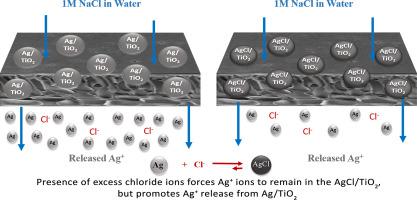当前位置:
X-MOL 学术
›
Desalination
›
论文详情
Our official English website, www.x-mol.net, welcomes your feedback! (Note: you will need to create a separate account there.)
Development of AgCl-TiO2 xerogels entrapped antibacterial polyacrylonitrile membranes: The effect of high salinity water on silver release, antibiofouling and antibacterial efficacies
Desalination ( IF 9.9 ) Pub Date : 2020-10-01 , DOI: 10.1016/j.desal.2020.114496 Metin Uz , Filiz Yasar Mahlicli , Erol Seker , Sacide Alsoy Altinkaya
Desalination ( IF 9.9 ) Pub Date : 2020-10-01 , DOI: 10.1016/j.desal.2020.114496 Metin Uz , Filiz Yasar Mahlicli , Erol Seker , Sacide Alsoy Altinkaya

|
Abstract Silver-containing antibacterial membranes are commonly used to control biofouling during bacteria filtration. Unfortunately, fast and uncontrolled release of silver to water is a challenge since this causes mass accumulation of silver in water resources and insufficient long-term antimicrobial effect. To overcome these disadvantages, we propose to add AgCl-TiO2 xerogels (0–0.8 wt%) in the polyacrylonitrile membranes. The long-term silver retaining of the membranes was evaluated by measuring the silver release under filtration of deionized water in the absence and the presence of 1 M NaCl up to 5 days. The antibiofouling and the antibacterial efficacies were determined by measuring the changes in antibacterial activity and DI water flux of the membranes at the end of 5 days of E. coli filtration. The 0.2 wt% AgCl-TiO2 xerogel incorporated polyacrylonitrile membrane demonstrated a constant ~1 μg of silver release/cm2 per filtration cycle after a total filtration of 0.05 L/cm2 with 1 M NaCl solution. Additionally, it showed antibacterial efficacy and ~100% recovery of deionized water flux by simple backwashing with water after having been used in many E. coli filtration cycles. Thus, this membrane could potentially be used up to ~5.8 years for 8000 h a year for the filtration of high salinity water. Statement of novelty Silver-containing antibacterial membranes are commonly used to control biofouling during bacteria filtration. Uncontrolled release of silver from the membrane causes massive silver accumulation in water which in turn leads to contamination of water resources and threat to aquatic organisms. Although silver release is strongly influenced by the salinity of water, the release data was collected through filtration of pure DI water or tap water in literature. To overcome the shortcomings of the published studies, we propose to use AgCl-TiO2 xerogels in membranes due to low solubility of AgCl in water and measure the release by filtering high-salinity water.
中文翻译:

AgCl-TiO2 干凝胶包裹抗菌聚丙烯腈膜的开发:高盐度水对银释放、抗生物污垢和抗菌功效的影响
摘要 含银抗菌膜通常用于控制细菌过滤过程中的生物污染。不幸的是,银快速且不受控制地释放到水中是一个挑战,因为这会导致银在水资源中大量积累,并且长期抗菌作用不足。为了克服这些缺点,我们建议在聚丙烯腈膜中添加 AgCl-TiO2 干凝胶(0-0.8 wt%)。通过在不存在和存在 1 M NaCl 的情况下测量去离子水过滤下的银释放量来评估膜的长期银保留量长达 5 天。通过测量大肠杆菌过滤 5 天结束时膜的抗菌活性和去离子水通量的变化来确定抗生物污垢和抗菌功效。0。在使用 1 M NaCl 溶液进行 0.05 L/cm2 的总过滤后,掺入 2 wt% AgCl-TiO2 干凝胶的聚丙烯腈膜表现出恒定的 ~1 μg 银释放/cm2 每个过滤周期。此外,它在许多大肠杆菌过滤循环中使用后,通过简单的用水反洗显示出抗菌功效和约 100% 的去离子水通量回收率。因此,这种膜有可能使用长达 5.8 年,每年 8000 公顷,用于过滤高盐度水。新颖性声明 含银抗菌膜通常用于控制细菌过滤过程中的生物污染。银不受控制地从膜中释放会导致水中大量银积累,进而导致水资源污染和对水生生物的威胁。尽管银的释放受水盐度的强烈影响,但文献中的释放数据是通过过滤纯去离子水或自来水收集的。为了克服已发表研究的缺点,由于 AgCl 在水中的溶解度低,我们建议在膜中使用 AgCl-TiO2 干凝胶,并通过过滤高盐度水来测量释放。
更新日期:2020-10-01
中文翻译:

AgCl-TiO2 干凝胶包裹抗菌聚丙烯腈膜的开发:高盐度水对银释放、抗生物污垢和抗菌功效的影响
摘要 含银抗菌膜通常用于控制细菌过滤过程中的生物污染。不幸的是,银快速且不受控制地释放到水中是一个挑战,因为这会导致银在水资源中大量积累,并且长期抗菌作用不足。为了克服这些缺点,我们建议在聚丙烯腈膜中添加 AgCl-TiO2 干凝胶(0-0.8 wt%)。通过在不存在和存在 1 M NaCl 的情况下测量去离子水过滤下的银释放量来评估膜的长期银保留量长达 5 天。通过测量大肠杆菌过滤 5 天结束时膜的抗菌活性和去离子水通量的变化来确定抗生物污垢和抗菌功效。0。在使用 1 M NaCl 溶液进行 0.05 L/cm2 的总过滤后,掺入 2 wt% AgCl-TiO2 干凝胶的聚丙烯腈膜表现出恒定的 ~1 μg 银释放/cm2 每个过滤周期。此外,它在许多大肠杆菌过滤循环中使用后,通过简单的用水反洗显示出抗菌功效和约 100% 的去离子水通量回收率。因此,这种膜有可能使用长达 5.8 年,每年 8000 公顷,用于过滤高盐度水。新颖性声明 含银抗菌膜通常用于控制细菌过滤过程中的生物污染。银不受控制地从膜中释放会导致水中大量银积累,进而导致水资源污染和对水生生物的威胁。尽管银的释放受水盐度的强烈影响,但文献中的释放数据是通过过滤纯去离子水或自来水收集的。为了克服已发表研究的缺点,由于 AgCl 在水中的溶解度低,我们建议在膜中使用 AgCl-TiO2 干凝胶,并通过过滤高盐度水来测量释放。



























 京公网安备 11010802027423号
京公网安备 11010802027423号